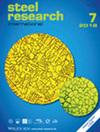Evolution Mechanism of Nonmetallic Inclusions in Fe‐1.5Al‐xSi (x = 0.5–3.0 wt%) Alloyed Steels
IF 1.9
3区 材料科学
Q2 METALLURGY & METALLURGICAL ENGINEERING
引用次数: 0
Abstract
The effects of Si content of steel melts containing 1.5% Al as well as alloying sequence of Si and Al on the evolution of inclusions are investigated. The SiOFe-1.5Al-xSi (x = 0.5-3.0 wt%) 合金钢中非金属夹杂物的演变机制
研究了含 1.5% Al 的钢熔体中 Si 含量以及 Si 和 Al 的合金化顺序对夹杂物演变的影响。当在 1873 K 时向熔体中添加 Si(=0.5-3.0 wt%)时,主要会形成 SiO2 夹杂,并且夹杂物的面积分数 (AF) 会随着时间的推移而降低。随后在硅合金钢中加入 1.5% Al(即 3.0Si→1.5Al),由于 Al2O3 的形成,夹杂物的面积分数增加。优先硅合金化的种群密度函数(PDF)分析显示出分形分布,表明夹杂物是通过碰撞机制生长的。PDF 分析显示出对数正态分布,这是因为 Al2O3 包裹体在随后的 Al 合金后形成并增长。另外,在钢中优先添加 1.5% Al 时,会形成 Al2O3 簇。随着时间的推移,Al2O3 簇的 AF 会逐渐减少。当随后向铝合金钢中添加 3.0% 的 Si 时(即 1.5Al→3.0Si),主要会观察到单个的 Al2O3 颗粒。由于无论合金化顺序和 Si 含量如何,Al 合金都会导致 Al2O3 的形成,因此浮起和分离 Al2O3 簇对于提高高 SiAl 合金钢(如电工钢)的清洁度非常重要。
本文章由计算机程序翻译,如有差异,请以英文原文为准。
求助全文
约1分钟内获得全文
求助全文
来源期刊

steel research international
工程技术-冶金工程
CiteScore
3.30
自引率
18.20%
发文量
319
审稿时长
1.9 months
期刊介绍:
steel research international is a journal providing a forum for the publication of high-quality manuscripts in areas ranging from process metallurgy and metal forming to materials engineering as well as process control and testing. The emphasis is on steel and on materials involved in steelmaking and the processing of steel, such as refractories and slags.
steel research international welcomes manuscripts describing basic scientific research as well as industrial research. The journal received a further increased, record-high Impact Factor of 1.522 (2018 Journal Impact Factor, Journal Citation Reports (Clarivate Analytics, 2019)).
The journal was formerly well known as "Archiv für das Eisenhüttenwesen" and "steel research"; with effect from January 1, 2006, the former "Scandinavian Journal of Metallurgy" merged with Steel Research International.
Hot Topics:
-Steels for Automotive Applications
-High-strength Steels
-Sustainable steelmaking
-Interstitially Alloyed Steels
-Electromagnetic Processing of Metals
-High Speed Forming
 求助内容:
求助内容: 应助结果提醒方式:
应助结果提醒方式:


